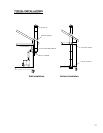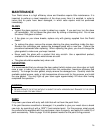
22
Smaller pieces of wood will dry faster. All logs exceeding 6" in diameter should be split.
The wood should not be stored directly on the ground. Air should circulate through the cord.
A 24" to 48" air space should be left between each row of logs, which should be placed in
the sunniest location possible. The upper layer of wood should be protected from the
element but not the sides.
TESTING YOUR WOOD
When the stove is thoroughly warmed, place one piece of split wood (about five inches in
diameter) parallel to the door on the bed of red embers.
Keep the air control fully open by pulling on it and close the door. If ignition of the piece is
accomplished within 90 seconds from the time if was placed in the stove, your wood is
correctly dried. If ignition takes longer, your wood is damp.
If your wood hisses and water or vapour escapes at the ends of the piece, your wood is
soaked or freshly cut. Do not use this wood in your stove. Large amounts of creosote could
be deposited in your chimney, creating potential conditions for a chimney fire.
THE FIRST FIRES
The fresh paint on your stove needs to be cured to preserve its quality. Once the fuel charge
is properly ignited, only burn small fires in your stove for the first four hours of operation.
Never open the air control more than necessary to achieve a medium burn rate.
Make sure that there’s enough air circulation while curing the stove. The odours could be
smelled during the 3 or 4 first fires. Never start your stove outside. You will not be able to
see if you are over heating.
IGNITION
After making sure that the stove air intake controls are fully open (completely pull-out
towards you), place several rumpled sheets of paper in the centre of the combustion
chamber. Place 8 to 10 pieces of small dry kindling wood over the paper in the form of a
tent. You may also place a few pieces of heating wood, but choose the smaller ones. No
chemical product should be used to light the fire.
Before igniting the paper and kindling wood, it is recommended that you warm up the
chimney. This is done in order to avoid back draft problems often due to negative pressure
in the house. If such is the case, open a window slightly near the stove and twist together a
few sheets of newspaper into a torch. Light up this paper torch and hold it as close as
possible to the mouth of the pipe inside the combustion chamber to warm up the chimney.
Once the updraft movement is initiated, you are ready to ignite the stove by lighting the
paper and kindling wood inside the combustion chamber.
We therefore advise you to leave the door slightly opened (1/4") for a 10 to 30 minutes
period, under supervision, in order to allow for good combustion. After this time, you must
close the door and progressively adjust the air control to obtain the desired temperature.


















